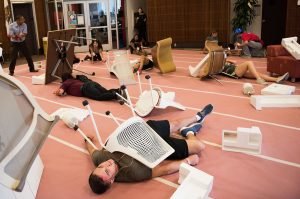University to participate in earthquake drill
Californians are constantly worried about possible earthquakes occurring when they least expect it. Recently, this fear has been exacerbated by an earthquake advisory that was announced earlier this month and ended on Oct. 4. While the thought of a natural disaster is daunting, USC is taking steps to ensure that students are safe in such situations.

Daily Trojan file photo
Shake the ground · Last year’s Great California ShakeOut had actors in makeup portraying people injured in an earthquake around campus.
This Thursday, USC will participate in the Great California ShakeOut, the largest disaster drill in history, with millions of people expected to participate. USC has been involved in this program since 2008 as part of the University’s extensive emergency-preparedness program. The drill is intended to help people feel prepared in case of a major earthquake and practice how to protect themselves in what could potentially be a life-threatening situation. All members of the University, including students, staff and faculty, are highly encouraged to participate, regardless of what part of campus they are on.
Hannah Hunt, a freshman majoring in global studies, commented on the importance of this drill to her as someone who isn’t originally from a place where earthquakes happen regularly.
“I’m from Connecticut, and earthquakes aren’t really an issue there, so I was never taught what to do in that sort of situation,” Hunt said. “I think USC’s drill is a really good idea, that way all students are on the same page and I’ll know how to protect myself if there’s ever a large earthquake while I’m living here.”
In addition to participating in the ShakeOut, the Office of Fire Safety and Emergency Planning recommends that everyone assemble an emergency kit with supplies such as food, water and first aid kits. In addition, it is important to make sure that items such as bookcases, TVs and cabinets are securely placed in homes, as they could collapse and cause damage or harm in the event of an earthquake.
The University prides itself on its continuity — there are multiple plans in place that are exercised annually. The Departmental Business Continuity Plans ensures that every school and department on campus has a plan for conducting their business offline until city services are restored. The IT Disaster Recovery Plans requires that every IT department on campus having a plan for backing up and restoring critical IT functions should the campus lose power, infrastructure or server capacity. Finally, the University’s financial officers are prepared to exercise emergency purchasing powers, payroll and accounting functions if the need ever arises. Once a major emergency has been stabilized, the University has plans in place to ensure everything returns to normal as smoothly as possible.
Steven Goldfarb, a fire safety and planning specialist from the USC Office of Fire Safety, said that the University is very prepared in case a major natural disaster ever hits campus.
“USC has an extensive, award winning all-hazards emergency management program,” Goldfarb said. “All schools and departments participate in planning, training and drills to ensure we can respond to and recover from all types of emergencies including fires, power outages, floods, weather incidents and much more. The University also has extensive business continuity plans to ensure critical services will be available.”
